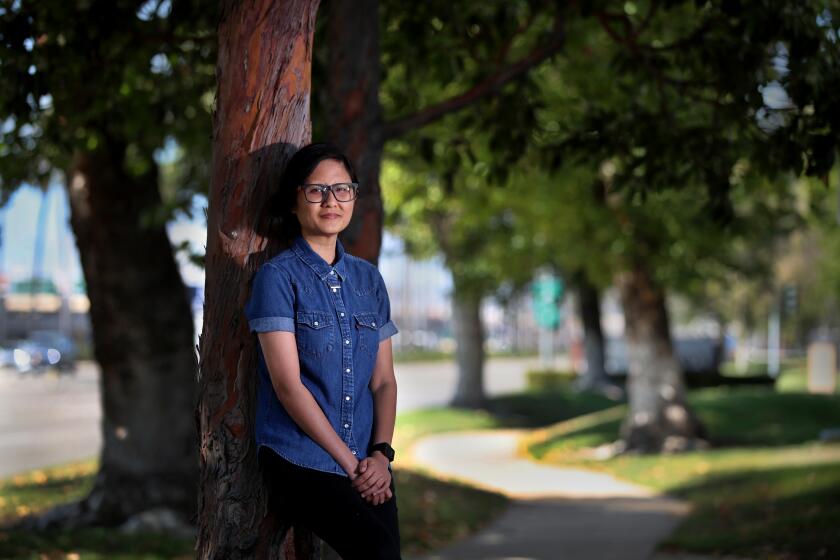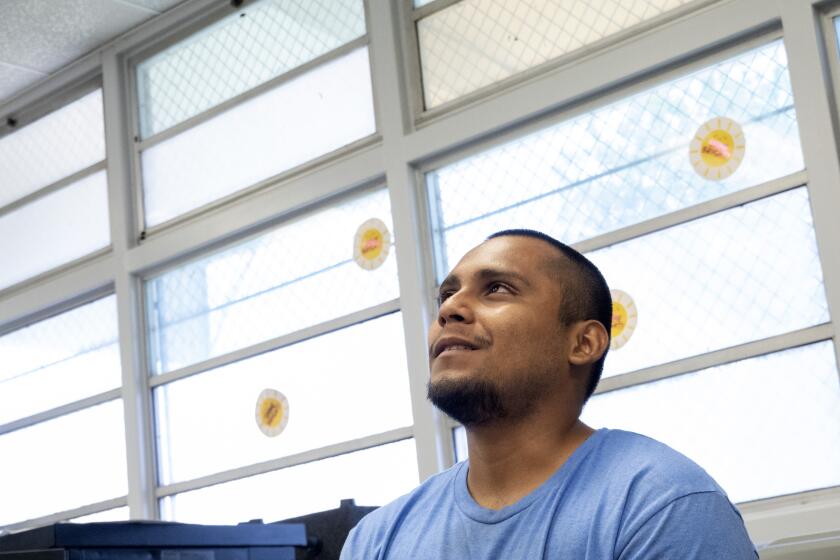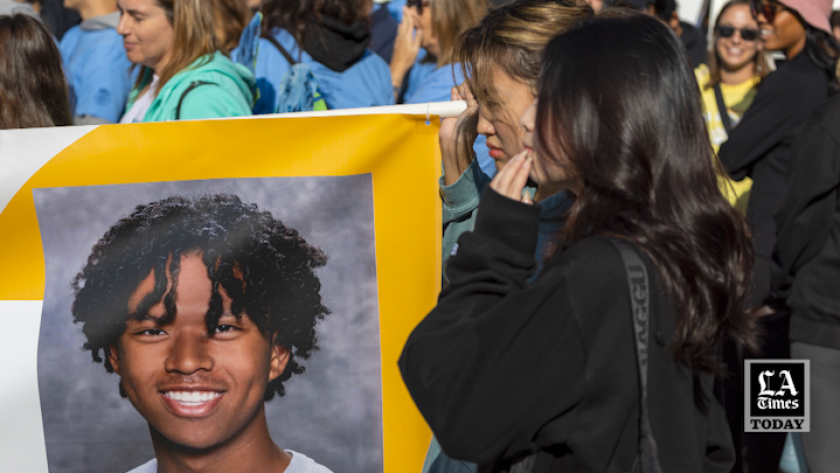
- Share via
For her 17th birthday, Jeramie Naya Vives Osorio’s family showered her with gifts: a dozen pink roses, a stack of Beard Papa‘s cream puffs, a Strawberry Sweet cake from the Korean bakery Tous les Jours and a small silver necklace from Tiffany.
Michelle Vives knew her middle daughter — Jer to her friends, Mia to her family — would never wear the necklace. But she wanted Mia to have it all the same.
“She loves Tiffany, so every birthday I get her something,” Vives said. “This year I bought her the infinity one” — a silver charm on a fine cable chain.
The Tiffany necklace lies with Mia’s ashes in a rose quartz urn in their Alhambra home. Insurance won’t pay for a burial, so her ashes wait in the dining room while her family saves for a niche at the Cathedral of Our Lady of the Angels.
“I buy her little things all the time,” her mother said. “I know you’re not supposed to have a favorite, but everyone knew she was mine.”
Mia died in March — eight weeks shy of her 17th birthday and at the mathematical epicenter of a terrifying new statistic.
This year, for the first time, the median age for teen suicide in Los Angeles County has dropped to 16 — the youngest ever.
::
Suicide has been a leading cause of death for young people for at least the last half-century.
But around the time Mia was born, those deaths began to surge, according to national data. Experts have struggled to explain why: Theories include Instagram and precocious puberty, easier access to guns, more stringent rules for prescribing antidepressants and increased use of hormonal contraceptives.
What they do know is that the age at which children kill themselves has been falling, while the ratio of girls to boys who die by suicide has climbed. In California, where teen suicide has been rising faster than in most states, the rate among Black and Asian youths is now higher than among white ones, according to California Department of Public Health data.
And all children, regardless of age, sex or race, are more likely to die during the school year than in the summer months, while suicides among adults show little seasonal variation.
Because these deaths follow the academic calendar, and because involuntary psychiatric hospitalizations for suicidal teens are reported summer to summer, The Times analyzed Los Angeles County Department of Medical Examiner data by school year.
In L.A. County, two-thirds of the three dozen students who killed themselves from the start of school in mid-August 2022 to the same time this year were 16 or younger, compared with half or fewer of those who died in the preceding five years.
Nearly half were girls — an unprecedented ratio in any age group examined in county, state or national statistics.
Taken together with state and national data, these deaths mark the post-pandemic coda to a suicide surge that began with the dawn of the smartphone era.
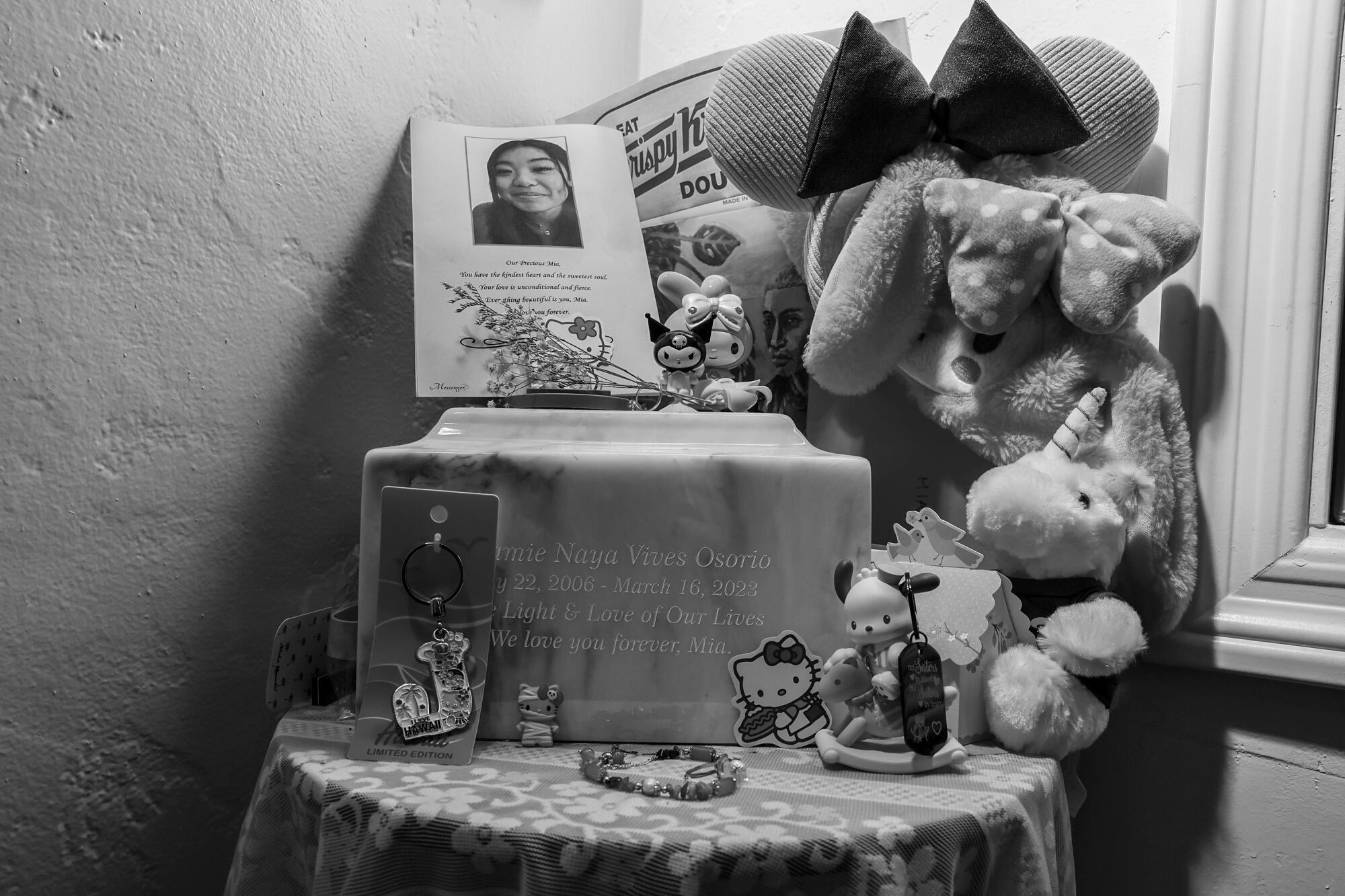
Despite its rapid rise in recent years, California’s teen suicide rate is still below the national average, a success experts peg to the state’s strict gun laws. California was also one of the first states to mandate suicide prevention plans in public schools after the passage of Assembly Bill 2246 in 2016.
Yet many of the systems meant to help children in crisis have been left to atrophy, and in some cases have been dismantled since the Great Recession.
Pre-pandemic, L.A. County had one acute psychiatric bed for every four children involuntarily hospitalized because they’d seriously hurt themselves or were about to, according to data from the California Department of Health Care Services.
Its ratio of children to pediatric psychiatrists was already higher than in almost any other major metro area, including New York, Chicago and Philadelphia, statistics from the American Academy of Child and Adolescent Psychiatry show. Only about 350 work in the county — virtually the same number as work in Manhattan, though Los Angeles is home to almost 2 million more children.
And clinicians were already seeing a surge in medical hospitalization for eating disorders, alarming experts who point to the high rates of suicide in patients who languish untreated — the majority of them girls.
Record waits and Byzantine rules stymie California’s poorest patients amid a surge in eating disorders that began early in the COVID-19 pandemic.
“After COVID, the rates went up tremendously, truly, truly tremendously,” said one emergency room doctor who asked not to be identified because he was not authorized to speak to the media.
“We didn’t even have enough rooms. Kids would overwhelm our pediatric ER, the medical side, because there was no room to send them to the psych ER. Oftentimes, they’d stay days.”
Such scenes are common across the U.S., according to a large retrospective study published in 2021.
This is what happened to Mia, and to at least a third of the dozen other 16-year-olds who died by suicide since last fall, according to death records and interviews.
Grieving parents interviewed by The Times said involuntary detention was a last resort. The process was traumatic for their children and often prohibitively expensive for their families. Yet most could not access other help. This outcome is so common, the California Mental Health Services Oversight and Accountability Commission dubbed it the “fail first” model.
Even Los Angeles Unified, the country’s second-largest school district, has foundered in its attempt to hire more mental health workers, a recent Times investigation found.
As systems of care have withered, an old superstition has taken root: that talking about suicide would cause people in crisis to kill themselves.
Just hours after her daughter’s death, Vives said, school officials and police showed up at her door, demanding to know when she planned to “go public” about Mia’s suicide.
“They were very concerned about it,” Vives recalled. “[They] said to me, right now, we have all the other kids on our watch. If anything happens to the other kids, we’re liable, and you, the parents, are liable.”
::
Since 2017, California public school systems have been required by state law to have suicide prevention plans “based on research and best practices.” These directives often include “action plans” for how to handle a student in crisis, lists of faculty and administrators who should respond, and requirements for ongoing professional development around suicide prevention.
Virtually all such plans in school districts statewide include the statement: “Empirical evidence refutes a common belief that talking about suicide can increase risk or ‘place the idea in someone’s mind.’”
An influx of billions of dollars of state funding is aimed at addressing the crisis, but the need is urgent.
Yet, in practice, that belief increasingly animates the response to teen suicide, survivors say.
“There’s a lot of parameters about how kids can collectively grieve,” said the mother of a 16-year-old who killed herself late last year. “You can’t have a public memorial. If you have anything, it has to be short and in a room where no one can see.”
The mother asked that she and her daughter not be named, fearing the stigma parents can face. But interviews, death records and social media profiles show that her daughter and Mia were alike in ways that mirror other L.A. students who died this year as well as emerging state and national trends.
Mia and her doppelganger were born days apart in May 2006 — one a Gemini, the other a Taurus. Both were Filipina American, both were being raised by single mothers, both were juniors at large public high schools in Los Angeles. They had the same Arctic Monkeys songs on their Spotify playlists, the same mirror selfies in their Instagram grids, the same dimpled smiles and shiny black hair. They even shared the same last initial: O.
Both Mia and O had also struggled with serious eating disorders, as well as tumultuous and abusive relationships with boys. Both had been involuntarily committed to the same South Bay psychiatric hospital.
Both died the same way.
Afterward, “I was advised by the principal not to have contact with her friends,” or even to accept their condolences, O’s mother said.
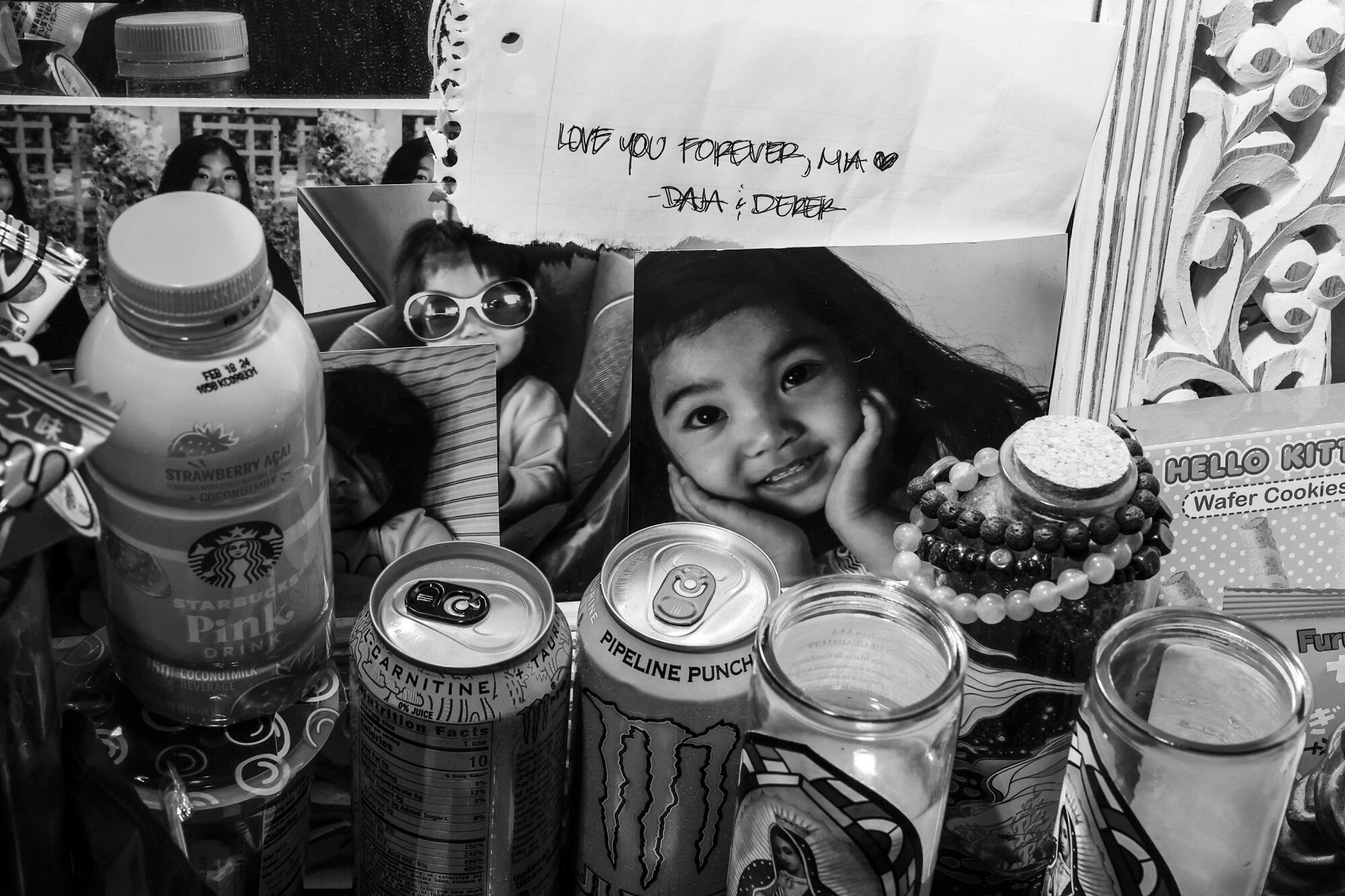
Experts interviewed by The Times said that advice shocked them.
“Telling families not to accept condolences is kind of mind-blowing to me,” said Janel Cubbage, a suicidologist who specializes in women of color. “Not talking about suicide is not helpful. It discourages people from coming forward, it discourages people from seeking help, it isolates people who experienced the suicide loss, and experiencing suicide loss can increase your risk for suicide.”
Yet survivors say such treatment is common.
In March, West Covina High School forbade a candlelight vigil for 16-year-old junior class vice president Samantha Vuong, despite approving one for a boy who killed himself in 2015, her sister said.
Devon Rose, the West Covina Unified School District’s director of student services, would not comment on the district’s response to student suicides, saying only that “WCUSD prioritizes the mental health of our students and staff” and offers annual suicide prevention training.
Lindsey Ma, the assistant superintendent of student support services at Alhambra Unified, Mia’s district, said it forbids memorials because the district is not staffed to handle the “large student outpouring of grief that could be triggered by on-campus events.”
“Students, particularly those most at risk, sometimes cannot control their anguish and require emergency mental health care,” Ma said in an emailed statement.
Since the start of the COVID-19 pandemic, local schools have fought bitter public battles with grieving students over memorials, yearbook tributes and other efforts to honor dead friends — actions that directly contravene the “best practices” districts commit to follow under their state-mandated suicide prevention plans.
“Oh my God, that’s horrific,” said Richard Lieberman, lead suicide prevention expert for Los Angeles County’s Office of Education and a proponent of the California law.
::
So why is it happening?
The school rules, like virtually all “postvention” guidelines for addressing suicide deaths, are particularly concerned with suicide contagion, an academic term for the way suicide reproduces in social groups.
Scholars do not debate whether contagion is real. Its disparate impact on young people is not in dispute. But its mechanism of action is murky. And how to prevent it — particularly among children — is murkier still.
“Postvention has always been the scariest for [schools],” Lieberman said. “It’s not just the brothers, the sisters, the classmates, the cousins — it’s vulnerable kids, it’s kids on the outer ring of the impact.”
Indeed, the children most at risk of contagion aren’t best friends or siblings, but classmates who knew the dead child in passing, or mutuals on social media, studies show. To prevent suicide from spreading among them, experts ask parents, teachers and traditional media to follow strict rules.
Memorials must not glorify suicide or the deceased; reports should not name any specific cause of death; suicides should never be attributed to any one trigger, such as a breakup or academic pressure; suicide notes should not be shared; and any discussion of suicide should be accompanied by crisis resources such as 988, the national suicide prevention lifeline, and Teen Line, a crisis hotline for youths staffed by Los Angeles high school students.
But none of these rules exist on the internet, where children exchange details, speculation and outpourings of grief unsupervised. Of the teenagers interviewed for this article, nearly all had learned of their friend’s death from a peer.
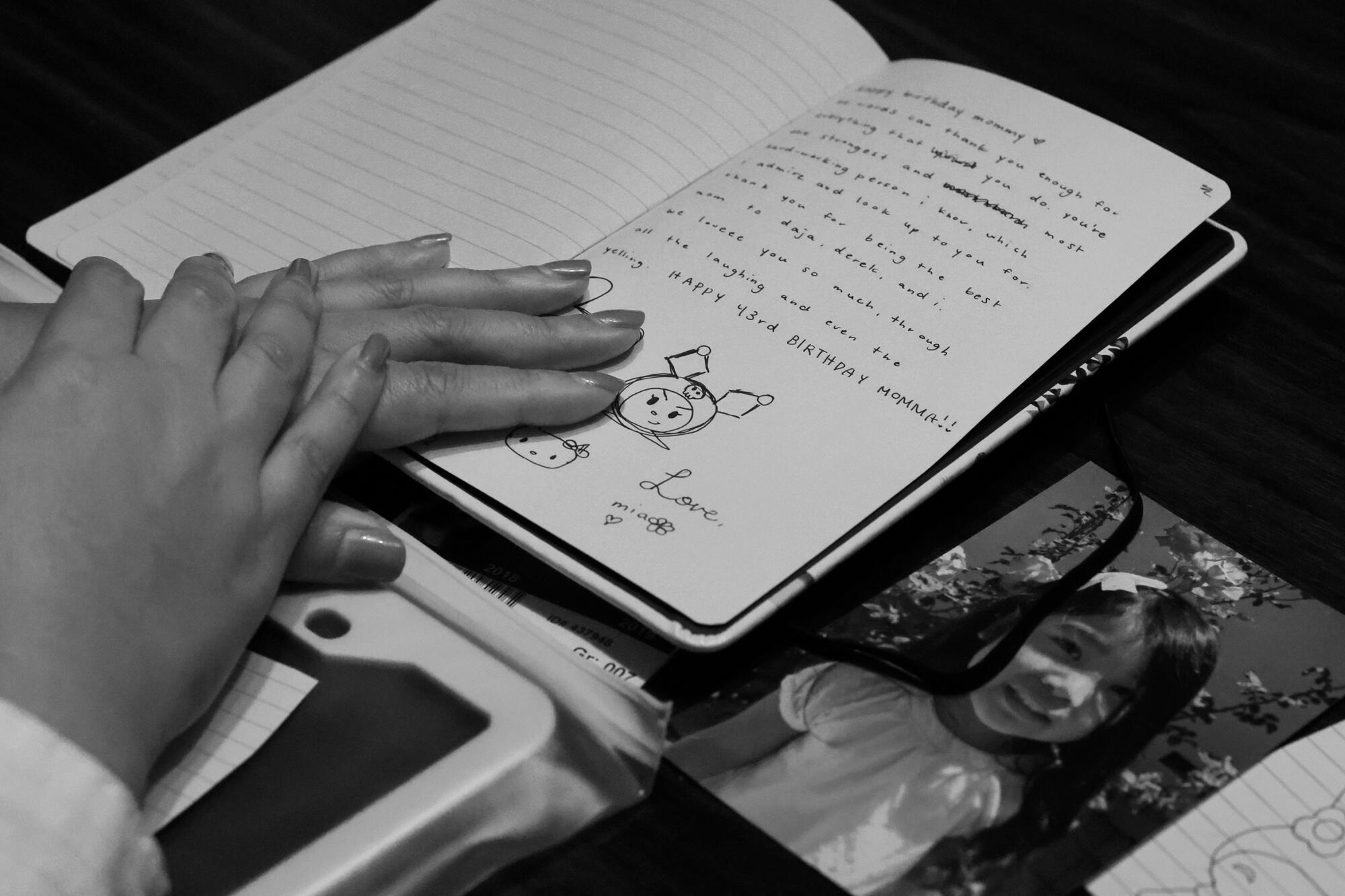
Some received suicide notes from their dead friends; others hunted for them in vain. They gave one another tattoos, wore dead friends’ clothes, kept prayer candles burning for months, transformed their Instagram pages into memorials. Many texted and called their dead friends. Some turned to drugs. Others were hospitalized.
Several could not be interviewed for this article, because they had ended their lives.
Among the L.A. County teenagers who killed themselves this last year, at least six were part of clear contagion clusters.
Mia belongs to one. Samantha belongs to another.
But the largest, by far, comes from Harvard-Westlake School.
::
Harvard-Westlake has long been among L.A.’s most prestigious private schools, a rite of passage for the scions of billionaires, Hollywood moguls and other established or aspiring elites.
Students, parents and teachers were deeply shaken when 15-year-old sophomore Jordan Park died by suicide there this spring. The method she used is relatively uncommon among teens in Los Angeles, and was once rare among girls, though data show a growing number now use it. (The Times is not naming the specific cause of death, in accordance with suicide prevention guidelines.)
Six weeks later, 18-year-old senior Jonah Anschell took his life using the same method. That’s when other private schools in Los Angeles County began to react. There were mass emails from other campuses to their own school communities, parent assemblies at feeder schools.
Park’s father killed himself days later. The response turned to panic. Then, in late June, 16-year-old rising junior Donald “Trey” Brown III died in the same way Park’s father had.
Four suicides in as many months of people connected to Harvard-Westlake. The cluster was undeniable.
“Some of the kids don’t even want to wear Harvard-Westlake merchandise anymore,” said parent Kalika Yap, who runs a mindfulness group at the school. “[Other] kids are like, ‘Oh, that’s the suicide school.’”
The cluster at Harvard-Westlake had not been reported in mainstream media by the time of the fourth death. Yet news had spread widely through TikTok and other social platforms.
“All the kids started making up stories, like, ‘We’ve had 25 suicides,’ ” Yap said. “They’ll come up with random numbers — meanwhile, there’s never been a [previous] suicide in decades.”
Palo Alto campus searches for healing after suicides
Statistically, poor children are much more likely to die by suicide than rich ones. But clusters at wealthy, high-achieving schools such as Harvard-Westlake and Gunn High School in Palo Alto loom large in the public imagination.
“The loss of any student is devastating for our entire community. Losing three students this past school year is unimaginable,” Harvard-Westlake President Rick Commons told The Times.
“While we don’t have reason to believe that these tragedies are linked to anything that happened at school, Harvard-Westlake is embarking on an even more expansive effort to address the current crisis in teen mental health.”
Commons did not elaborate on what that effort might be.
::
Unlike public districts, private schools are not bound by state law to have a suicide prevention plan, to respond to student deaths with evidence-based postvention methods, or to make public any policies they may have to prevent future deaths.
Yet even schools that follow the law to the letter find they have little sway on social media, on which graphic details and salacious speculation are algorithmically funneled to children who knew the deceased and to strangers who interact with similar content.
“Social media fuels contagion,” Lieberman said.
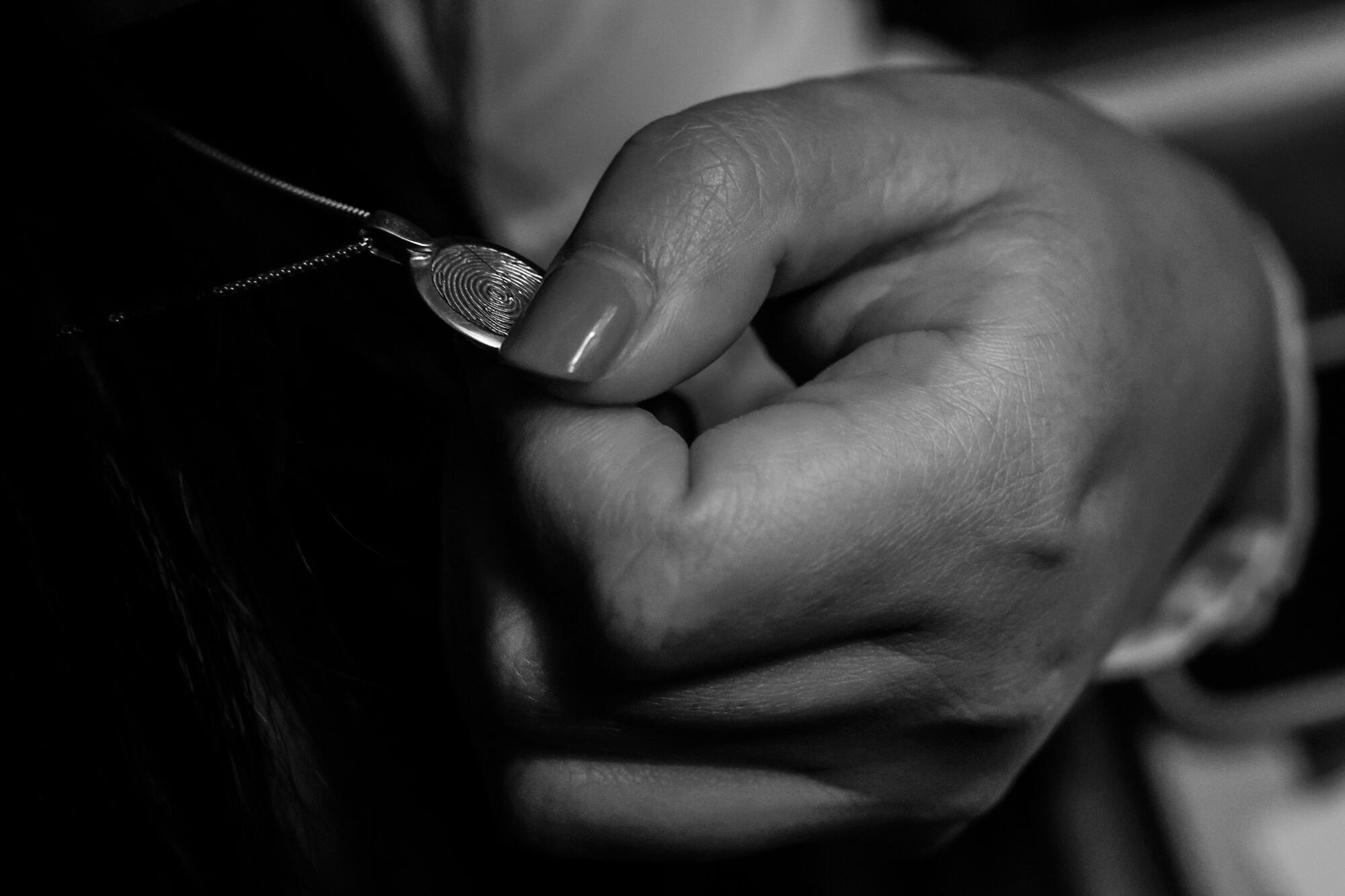
That’s because the children most at risk for suicide often hear about it from one another while scrolling on Instagram or browsing the comments section of viral TikTok videos.
Why r ppl saying “rest in piece” etc in the comments l’m so confused what happened??
She committed.
omg i was gonna make a joke about how it’s basically self-h*rm but she literally khs…
OMGG HOW ARE YOU!! WE WERE CLOSE WHEN WE WERE LITTLE?? i’m sorry but i get it i’m here for you if you need anything!! lmk :)
She’s not here anymore, like yk, she’s de@d…
These comments fill the page of a 16-year-old who died in the San Fernando Valley in December, using the same method as Mia and O. Her family asked that she not be identified in this story, fearing stigma for her siblings.
She too was being raised by a single mother, had been hospitalized and struggled to get follow-up care, her best friend said. Her penultimate TikTok, which has nearly 4 million views and more than 3,000 comments, shows her piercing her own face in multiple places, with the caption “Piercing myself is my therapy.”
Comments show many children who were already at risk found her video inadvertently, while scrolling their For You Page.
Others come to such posts to memorialize their friends, often after they’ve been forbidden to do so at school.
In the case of Mia and O, social media users found themselves inundated with pain and death as the algorithm surfaced more of what they’ve interacted with into their feeds.
“The panic just completely consumes people that are in positions to make these kinds of decisions, and ultimately what we’re doing is leaving kids to grieve and deal with it on their own,” Cubbage said.
In their rush to contain contagion, some parents and experts fear schools may have inadvertently amplified the threat.
“There’s not a lot of nuanced conversation about suicide other than, ‘Don’t do it,’” O’s mother said. “There’s a panic, as soon as you say those thoughts, you get hospitalized.”
::
With binds on my wrists, my ankles, and thighs, I was transported to the psych ward at 2:14 AM wearing nothing but a baby blue hospital gown and grippy socks...[They] stripped me naked to check my malnourished privates for cuts, bruises, and other forms of injury...Nurses shone flashlights in the nooks, the crannies...sketching my scars, my marks, my roughness on a sheet resembling a blank silhouette.
This is how O described her involuntary hospitalization in August 2021. An almost identical sketch accompanies her death report, its silhouette amended to include her fatal injury.
Like for many children who have since died by suicide, the return to school in August 2021 was for O the start of a cascade of crises.
“The hospitalization happened right when she was going back to school,” her mother said. “I thought I was sending [her] to a safe place.”
Instead, her daughter emerged traumatized, as do many children — particularly girls. Mia told her mother she was molested by a patient during one of her involuntary hospitalizations. Others described physical and emotional abuse.
“It’s a scary process,” said Mia’s friend Karla, who met her at a hospital in Ventura County. “They strip you naked and check your body, they ask you so many questions, you’re cold, you don’t know what’s going on, you’re confused — and then you get thrown in a room filled with a lot of teenagers.”
Experts like Cubbage warn that involuntary hospitalization could actually increase the risk of suicide. But many parents who talked to The Times said they had no choice.
“We’re sending them to the hospital because there isn’t any other option,” O’s mother said. “It’s the only answer we seem to have to this question.”
Children wanted help. Parents wanted to help them. Most had spent years seeking care, cycling through ERs and acute psychiatric facilities when they failed to get it.
“I was surprised we weren’t followed up,” O’s mother went on. “Even being a resourced person, it’s a lot for one person to do.”
Mia’s mother agreed. Her daughter was put on antidepressants while she was in the hospital. Yet Vives, a nurse with private insurance, said it was impossible to find a psychiatrist to refill the prescriptions once she was released.
“I relied on everyone else because I thought they were professionals,” she said of her daughter’s care. “I’m a single mom, I work really long hours. I was relieved other people were helping.”
But the help she could access was extremely limited. Mia earned a certificate for healthy relationships from a school-based program while continuing to see her troubled boyfriend. The trainee social worker she visited at school in the months leading up to her death didn’t notice she’d lost 30 pounds.
When she voiced distress, she was put on a 5585 psychiatric hold and returned to a locked facility with other vulnerable adolescents, whose own social networks were filled with children in despair.
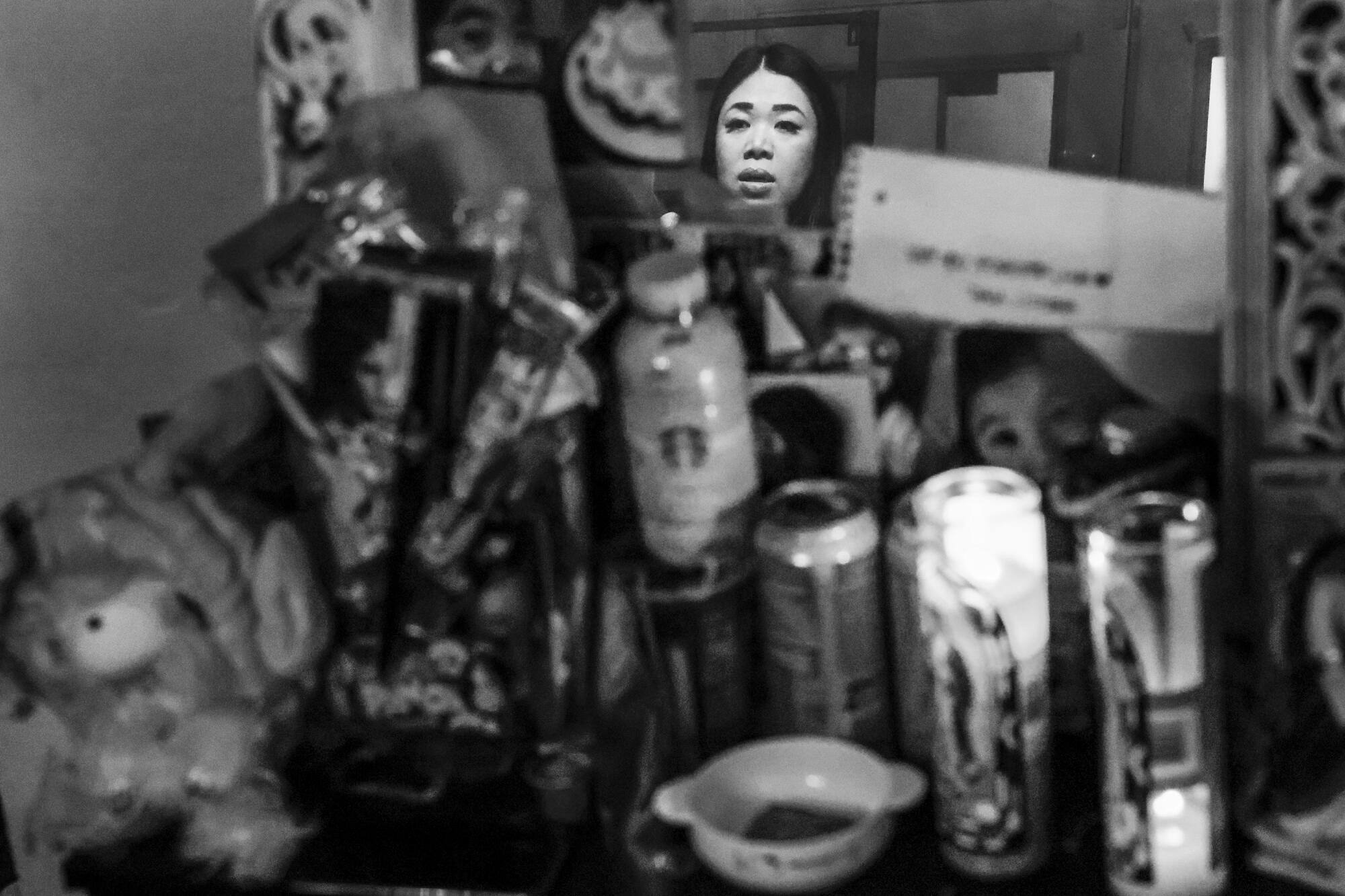
New data from the federal Centers for Disease Control and Prevention show 1 in 3 teen girls has seriously considered suicide, sparking fears among some suicidologists that the same strong social connections long considered protective for girls are now putting them at risk.
That’s clearly true of eating disorders, which have surged in the wake of the pandemic. Though social media have long been understood to fuel these diseases, cases exploded amid the return to classrooms, where some young people developed disordered behaviors as a form of social bonding.
“[Mia] met this girl when she first started in-person schooling,” Vives said. “Mia would tell me [her friend] would force Mia to throw up with her.”
The current surge in eating disorders has been especially acute among poor patients and girls of color, fueling their risk of suicide, experts warn.
But they aren’t the only risks girls such as Mia face.
It’s now common for children to keep in touch with friends they make during involuntary detentions, including teens who live counties away. When those friends die — as scores of Southern California children do every year — the news rips through the feeds of vulnerable teenagers who would never otherwise have met.
“There was someone she just met [at the hospital] and three months later she sees on Instagram she passed away,” Vives said. “And then the next one she went to, ‘Oh, so-and-so killed themselves,’ and even the last one [in June 2022], it’s on Instagram. It was almost, like, glamorized for them.”
For friends, those posts are a way to process grief they are not allowed to express at school and may fear to tell their parents.
“Every month on the day she passed away I’ll post a picture of me and her, or like a video,” said the best friend of a TikTok star who died in December.
Like him, most have no inkling they could cause harm, and no knowledge of how such risk might be mitigated.
Even a girl who wrote she hoped Mia would “tie a noose” in the weeks leading up to her death is herself a veteran of involuntary detention. Her friends from those commitments follow her and comment on her page, as Mia’s did.
“It reminds me of the arguments against sex ed — if we talk about it, they’re going to do it,” Cubbage said. “They’re already doing it. It’d be best if we stopped pretending that they weren’t.”
Suicide prevention and crisis counseling resources
If you or someone you know is struggling with suicidal thoughts, seek help from a professional and call 9-8-8. The United States’ first nationwide three-digit mental health crisis hotline 988 will connect callers with trained mental health counselors. Text “HOME” to 741741 in the U.S. and Canada to reach the Crisis Text Line.
- Share via
Watch L.A. Times Today at 7 p.m. on Spectrum News 1 on Channel 1 or live stream on the Spectrum News App. Palos Verdes Peninsula and Orange County viewers can watch on Cox Systems on channel 99.
More to Read
Sign up for Essential California
The most important California stories and recommendations in your inbox every morning.
You may occasionally receive promotional content from the Los Angeles Times.

